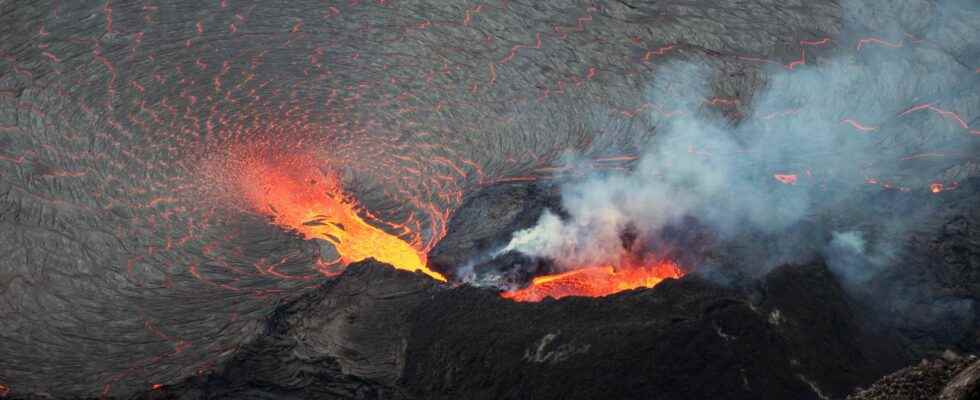Since the start of the eruption more than four months ago, lava has filled the summit crater which was formed following a major lateral eruption in 2018. But this filling is not regular, because the lava supply is discontinuous. Thus, sometimes the volcano pauses for several hours. Then, the lava returns and feeds a lake whose level increases until sometimes overflowing… Some time later, the drop in this level announces a new pause, and so on.
You will also be interested
[EN VIDÉO] Kilauea volcano eruption Cascading lava plunges into the lake in multiple places, causing local upwellings. When the waterfalls enter the lava lake, they cause the surface of the lake to slide and pull pieces of cooled crust below the surface.
On the island of Hawaii, Kilauea is one of the most active volcanoes on the planet, but also one of the best monitored. The devices there are extremely sensitive, which allows, for example, the recording of minute deformations of the volcano. Since the beginning of December 2021, these have been showing an alternation of very modest deflation and swelling, similar to a kind of breathing. These DI episodes, for deflation / inflation, are the consequence of variations in pressure in the superficial magmatic reservoir of the volcano.
The eruption took place at the bottom of the caldera Halema’uma’u at the summit of Kilauea, precisely at the level of two vents located to the west of this crater: a small cone and a pond about fifteen meters in diameter, both connected to the volcanic conduit. The lava flows they have emitted since the start of theeruption on September 29, 2021 formed a flat-bottomed crater of approximately 1,200 x 800 meters.
Currently, these two vents feed a lava lake to the west of this crater, roughly triangular in shape from 200 to 300 meters on a side, and it is precisely at this place where we can notice that theeruptive activity sticks strictly to these deflation/inflation episodes. To illustrate this, here is the sequence associated with the sequence from February 7 to 10 which was recorded by a thermal camera and whose images were compressed to produce the time lapse seen below.
Time-lapse of Kilauea’s eruptive activity between February 7 and 10, 2022. Note that the crater is also filling up with lava tunnel activity, especially on the edges. © U.S. Geological Survey
The deflation that began in the early morning of February 7 caused the lake level to drop by about 12 meters (12 – 19 sec on the video). Around 8 p.m. local time, the activity was thus limited to the only small lava pond and this, for more than a day (19 – 34 sec). On February 8, around 12 p.m., an inflation was noticed, followed thirteen hours later by a new supply of the lake by the pond, but also by the overflow of the latter at 2 a.m. on February 9, at the origin of a long flow in the northern part of the crater for several hours (35 – 39 sec). The level of the lava lake then fell until 9 p.m. (39 – 45 sec), but the resumption of more vigorous feeding led to the pond overflowing again to the north shortly before midnight on February 9 (47 – 55 sec). The lava lake was then fed until 6 p.m. on February 10, when another deflation occurred.
A massive collapse in 2018 created a deep crater that has since been filling
A side rash magnitude took place at low altitude between May 3 and September 4, 2018, destroying 716 dwellings and covering nearly 50 kilometers of road. It put an end to thirty-five years of continuous activity on this volcano (a record!) and the important volume emitted led to the emptying of the superficial magmatic system of the volcano, at the origin of thecaldera subsidencethe bottom of the crater being 500 meters lower than before this lateral eruption!
Between December 2020 and May 2021, a first eruption occurred at the bottom of the crater, raising its level by around 230 meters. The current one, which began on September 29, 2021, has so far raised this level by around 90 meters, for an estimated volume on January 28 of 45 million m3. the debit average eruptive height of this eruption is thus 4 m3/s approximately, which is quite modest, even if it would nevertheless fill an Olympic swimming pool in approximately thirteen minutes!
Interested in what you just read?
